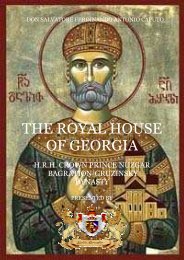here - Nobility Associations
here - Nobility Associations
here - Nobility Associations
You also want an ePaper? Increase the reach of your titles
YUMPU automatically turns print PDFs into web optimized ePapers that Google loves.
princes. The German king has become one of the weakest rulers on the Continent.<br />
The Great Interregnum (1254-1273), as this period will be known to history, is a<br />
stormy and confused period. It is the kaiserlose, schreckliche Zeit "the terrible time<br />
without an emperor." Western Europe is now about to enter a new phase. The<br />
Great Interregnum comes to an end in 1273. In that year, the imperial crown is<br />
revived and given to the Austrian Count Rudolf of Habsburg. The Empire now has<br />
an Austrian head.<br />
Rudolf's ancestors — of Trojan and Merovingian descent — had built a family castle<br />
in Switzerland in the 11th century. They had called it Habichtsburg — Castle of the<br />
Hawk. Hence, the word Habsburg. Rudolf is the first Habsburg to ascend the<br />
imperial throne. He will succeed in establishing some degree of order within the<br />
Empire. The House of Habsburg will play a leading role in European affairs for<br />
centuries to come. The ideal of universal rule — unity under a single authority — is<br />
by no means dead.<br />
Legacy<br />
With Conradin's death at 16, the legitimate Hohenstaufen line became extinct. His<br />
remains, with those of Frederick of Baden, lie in the church of the monastery of<br />
Our Lady of Mt. Carmel at Naples, founded by his mother for the good of his soul;<br />
and <strong>here</strong> in 1847 Maximilian, crown prince of Bavaria, erected a marble statue by<br />
Bertel Thorvaldsen to his memory. In the 14th century Codex Manesse, a collection<br />
of medieval German lyrics, preserved at Heidelberg, t<strong>here</strong> appear two songs written<br />
by Conradin, and his fate has formed the subject of several dramas.<br />
His <strong>here</strong>ditary Kingdom of Jerusalem passed to the heirs of his great-greatgrandmother<br />
Isabella I of Jerusalem, among whom a succession dispute arose. The<br />
senior heir in primogeniture was Hugh of Brienne, a second cousin of Conradin's<br />
father, but another second cousin Hugh III of Cyprus already held the office of<br />
regent and managed to keep the kingdom as Hugh I of Jerusalem. Conradin's<br />
grandmother's first cousin Mary of Antioch also staked her claim on basis of<br />
proximity of blood, which she later sold to Conradin's executioner Charles of<br />
Anjou.<br />
Memorial by Thorvaldsen<br />
The general heiress of his Kingdom of Sicily and the Duchy of Swabia was his aunt<br />
Margaret, half-sister of his father Conrad IV (the youngest but only surviving child<br />
of Frederick II and his third wife, Isabella of England) and married with Albert,<br />
Landgrave of Thuringia since 1255. Their son Frederick claimed Sicily and Swabia<br />
on her right.<br />
The Hohenstaufen Dynasty - Page 85 of 200



